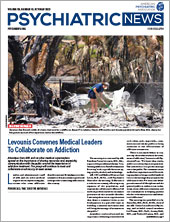Before the world ground to a halt in an effort to contain the COVID-19 virus, the hybrid model of telepsychiatry was envisioned as a means of encouraging greater adoption of telehealth. With hybrid care, psychiatrists could connect in person with patients in the clinic as well as virtually with those at home or in community settings. Most of those practicing telepsychiatry divided their time between seeing patients in person and online, but they did not move their practice out of their clinics. Instead, a portion of the established caseload was strategically offered a virtual care option after some degree of screening and orientation of the patients. While slow at first, the adoption of a hybrid model of telepsychiatry was making gradual inroads among psychiatrists, where it was seen as having little threat to the overturning of more traditional workflows.
All this changed when COVID-19 triggered a dramatic worldwide response. Almost overnight, telemedicine went from unusual and optional to nearly mandatory, as patients and clinicians alike feared the possible spread of the virus at in-person appointments. Telepsychiatry’s doubters and skeptics soon became reluctant adopters—relying on texts, phone calls, and video to connect with patients. Instead of taking these calls and videos from the clinic, many clinicians shifted more to working from home for at least part of their time. For many patients with mental health concerns, the physical clinic was suddenly no longer their place to receive care.
Some data suggest mental health and substance use visits delivered via telehealth jumped about 40% from the start of the pandemic to mid-2020.
The abrupt transition to telepsychiatry was not without a cost. Many clinicians, especially trainees, did not have homes with the physical capacity for a private office or clinical workspace. Even if they did, partners working from home and the needs of children being home-schooled still made patient privacy hard to achieve or maintain consistently. There was little time to adjust to the new model of care and few received meaningful training for their newly assigned (and unrequested) role as “tech support” for patients. Office staff became the point of contact for frightened and sometimes desperate patients who suddenly had no clear idea of how or if they would be meeting with their doctors. Of course, it could have been worse if not for the improvements in cloud-based videoconferencing software that made all that followed possible.
Today, even as much of the U.S. health care system has returned to normal,
evidence shows that patients continue to seek telehealth for mental health services and many clinicians are working part-time at home and part-time in a clinic environment. These providers are perhaps seeing differing cohorts of patients in each place, or one group of patients who are choosing both in-person and online care, depending on convenience and need.
So which direction will we go with the “new” hybrid care, where both patients and clinicians can gain the key advantages of the hybrid model, namely flexibility and improved access in the delivery of care from both time and geographic perspectives? A lot depends on the post-pandemic regulatory environment.
In May 2023, just days before the expiration of the COVID-19 Public Health Emergency (PHE), the Drug Enforcement Administration (DEA) and the Substance Abuse and Mental Health Services Administration (SAMHSA)
issued a temporary rule extending full telemedicine flexibilities adopted during the COVID-19 PHE through November 11.
If these agencies continue to allow something approaching parity between in-person and virtual care, the same sort of clinical activities that are happening today will be able to be continued in clinics or providers’ homes. This would allow clinicians to increasingly separate out their patients into sessions of those being seen from their homes for online care, and sessions of in-person care in clinics, where they may share offices or workspaces with colleagues, rather than having a full-time personal office.
If the DEA returns to a more restrictive approach to prescribing of controlled substances that limit or eliminate non-clinical sites as point of origination for most telehealth visits, the old model of the brick-and-mortar office will have more of an advantage in the future. If that position is taken by the DEA and cannot be easily corrected, then the subset of patients requiring controlled substances, especially those with substance use disorders, may need to be seen primarily at in-person facilities with fewer hybrid practice options available.
In the end, some clinics and clinicians may conclude that it makes little sense to continue to see patients in costly commercial real estate spaces if the same service can be provided at a lower cost (via lower overhead) and greater convenience (via elimination of many of the logistical barriers) through telemedicine services originating from non-clinical sites such as the clinician’s home. The hybrid model offers the opportunity to provide a part or all clinical services at a low or no added overhead expenditure.
It’s hard to believe that today’s patients and clinicians, who are both now used to having the advantages and conveniences of hybrid care, are going to want to go back to working in pre-pandemic models. Let us hope that the DEA understands this. ■

